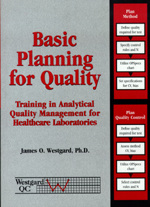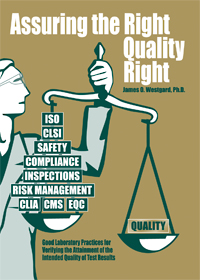Basic Planning for Quality
QP-12: Immunoassay Applications
The Quality Planning Process in action! Recently a survey of immunoassay instruments in CAP TODAY said that immunoassay methods were the "trickiest" to QC. But no matter how difficult or tricky, you can still plan quality for it. Examples in this lesson show how to choose control rules and materials for thyroxine, cortisol, thyroid stimulating hormone, and more. General suggestions for immunoassays are also given. (Preview)
- Quality requirements
- Method imprecision and inaccuracy
- Example applications
- Planning and implementation strategies
- References
Quality planning for immunoassays poses some special difficulties because there are usually multiple decision levels, different quality requirements at these different decision levels, and different method CVs at different decision levels. The title of an April 2000 survey of immunoassay instruments in CAP TODAY makes the point - "Of all analyzers, immunoassay the trickiest" [1]. QC designs may be more complicated because immunoassay measurement procedures are generally not as precise as the highly automated chemistry and hematology methods, therefore it may be necessary to utilize multi-level or multi-stage designs, often with multirule control procedures and a higher number of control measurements.
Quality requirements
Endocrine tests and some toxicology tests are commonly performed by immunoassay methods. CLIA's list of regulated endocrine tests is short - only seven tests - cortisol, free thyroxine, human chorionic gonadotropin, T3 uptake, triiodothyronine, thyroid stimulating hormone, and thyroxine. For all but cortisol and thyroxine, the quality requirements are given as Target Value plus and minus 3 SD, where the SD here is estimated from the group of laboratories participating in the proficiency testing survey. For Cortisol, the allowable total error is given as 25%; for thyroxine, the allowable total error is given as 20% or 1.0 mcg/dL, whichever is greater. CLIA's requirements for toxicology are generally stated as Target Value plus and minus 20 or 25%, the higher figure being used most often.
For other assays, it would seem appropriate to extend the 3 SD peer group concept and utilize the data from inter-laboratory peer comparison programs and external quality assessment programs as the starting point for defining the quality requirements. Clinical quality requirements may also be used, but their application requires access to more sophisticated planning tools, such as a more complex clinical quality-planning model and a computer program, such as the EZ Rules program [2-3], to carry out the calculations.
Method imprecision and inaccuracy
Imprecision is estimated from replication studies that are typically carried out with three or more levels of control materials. The SDs observed and the CVs calculated are likely to vary widely from low to high end of the reportable range. CVs may be as large as 10 to 15% at one end of the range and typically will be about 5% in the most precise part of the range. Inaccuracy can be assessed from comparison of methods experiments, but the lack of reference methodology makes it difficult to assign systematic errors to one method or the other. Therefore, it is widespread practice to assess systematic errors by comparison to like methods in monthly peer-review programs or periodic proficiency testing surveys.

 We invite you to read the rest of this article
We invite you to read the rest of this article
Note: This material is covered in the Basic Planning for Quality manual, which is availalbe in our online store. You can download the Table of Contents and additional chapters here.
Updated and expanded coverage of these topics can be found in Assuring the Right Quality Right,also available in our online store. You can also download the Table of Contents and additional chapters here.
Finally, you can access materials online on these topics by enrolling in the Management and Design of Analytical Quality Systems course course.
